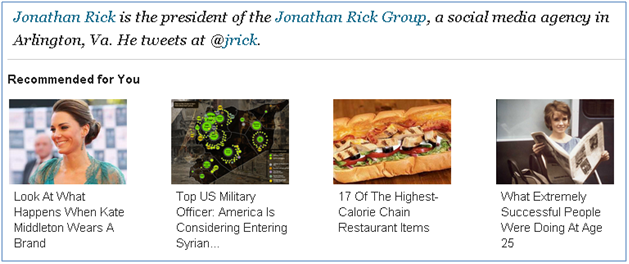That italicized sentence at the bottom of your blog posts isn’t a necessary evil, but an easily exploitable opportunity.
Ten years ago, after you finished reading a book, watching a movie, or listening to a song, it was over; you were done. If you wanted to share your reactions, you saved them for the water cooler.
Today, the traditional indicators of finality — a tombstone mark for an article (∎), the words “the end” for the silver screen, a trio of hashtags (###) for a news release — have been supplanted by a button that beckons you tinno “like,” “retweet,” “pin,” or perform some other variation of social-media sharing.
For example, by displaying a hash tag, TV commercials encourage you to “join the conversation” on Twitter. Magazine articles refer you to a website “for more information.” Even McDonald’s has climbed aboard the bandwagon, stamping QR codes that reveal nutritional data on its carryout bags.
How can you, dear blogger, get in on these gigs and thus propagate your posts? Specifically, how can you milk your content for more followers and fans?
Easy: just start making use of an often-overlooked implement in the marketer’s toolkit: your byline.
That italicized sentence at the bottom of your blog posts isn’t a necessary evil, but an easily exploitable opportunity. This is fertile real estate. Don’t treat it as a frivolous half-bathroom, but as a stately guest room in your marketing plan. (Other quarters include your email signature and website address.)
Indeed, in our age of the infinite scroll, you can ignore the op-eder’s commandment to cram your byline into a line or two. Instead, unleash your inner self-promoter. Here’s how the pros do it.
Good
“She’s not promoting it, but she can be found on Twitter at @digitalori.”
C’mon, Lori. Don’t be coy — you know you want more followers. I know you want more followers. Shout it from the rooftops!
Better
“Follow Richard Levick on Twitter and circle him on Google+, where he comments daily on the issues impacting corporate brands.”
Effective? Yes. Yet it could be stronger.
Consider: we’re asked to follow Richard because he “comments on the issues impacting corporate brands.” That’s intriguing, but not really click-worthy. Since his article focuses on utility companies, he could have been more specific:
“Follow Richard Levick on Twitter and circle him on Google+, where he serves up bleeding-edge ways for utility companies to harness social and digital media.”
And while we’re at it, let’s link his name “Richard Levick” to his webpage.
Great
“Tour Guides Nate Hindman and Joe Epstein are ‘On the Road With Free Enterprise,’ visiting small businesses and entrepreneurs checking out local events, and telling the story of free enterprise in more than 20 American communities this summer. Follow their travels on Facebook, Twitter, and Instagram.”
Here, we see the byline hitting its stride. In addition to the social solicitations, we’re also treated to an argument why we should follow these guys (who are colleagues).
Perfect
“What’s your favorite post-[Google] Reader RSS reader? Send your review of it in the form of a love letter to Shafer.Reuters@gmail.com. I wish my Twitter feed could still support RSS. Sign up for email notifications of new Shafer columns (and other occasional announcements). Subscribe to this RSS feed for new Shafer columns. Hurrah for RSS!”
Hurrah for Shafer! Not only does Jack manage four promos in 50 words. More important, he weaves them into a cohesive narrative that cleverly plays off his column (on the demise of Google Reader). A Shafer byline isn’t an outlier; it’s part and parcel of the text.
Yes, But…
“This sounds intriguing,” I can imagine some of my coworkers thinking. “Sure, it’s low risk and low effort. But what’s the payoff?”
In my experience, one of the best measures of an article’s resonance is how many Twitter followers it spurs to react. Once someone has finished reading, she faces a critical choice: she can move on to something else, or she can engage with you. Engendering engagement is a clear sign you’ve earned a second date, that you’ve converted a one-night stand into a potential relationship. These are the folk who don’t just passively follow you, but reply and retweet.
Some may still object that adding these supercharged shout-outs smacks of desperation. After all, doesn’t your website already carry the familiar grid of social-media icons that direct people to your channels?
Yes, but that’s hardly enough. Just as we need to encounter a word repeatedly until it becomes part of our working vocabulary, so we need to be reminded — thoughtfully, not relentlessly — of opportunities to continue the conversation. If 80% of success consists of showing up, then 80% of your fan base comes from nudges — pop-ups, prods, and prompts. These calls to action can be as sophisticated as a multimillion-dollar ad buy, or as a simple as a yeasty byline.
Blog-Wide Bylines
Of course, bylines aren’t limited to individuals. If we stretch the definition — from links that lengthen the lifecycle of the given post to the given publication — bylines can also serve as bait for blogs as a whole.
Here’s the fishing rod used by the Atlantic Wire:
“Want to add to this story? Let us know in comments or send an email to the author at [redacted]. You can share ideas for stories on the Open Wire.”
For its part, Mashable reels readers in with a specific question. For example:
“Is Silver’s move to ESPN a smart call, or is he making a mistake? Give us your take in the comments.”
However you phrase it, a blog-wide byline is like a (clockless) casino: it propels your readers ever-forward while keeping them within your orbit.
Related Content
One final word. Below the byline, many publications showcase “related content,” or algorithmically similar posts “you may also enjoy.” Here’s how Business Insider exploits this opportunity:
These recommendations increase your readers’ time on site and thus their likelihood of engagement.
The web offers endless opportunities to market yourself. By bedecking your blogs with bylines and related content, you breathe new life into them. Why limit yourself to one act when everyone else is partaking of their second?
If you don’t follow me on Twitter, you’ll be telling the world you hate puppies.
A version of this blog post appeared in Fast Company on August 28, 2013.
Addendum (5/18/2014): A key insight from Paul Berry, who helped found the Huffington Post: “At the New York Times, far too often for writers and editors the story is done when you hit publish. At Huffington Post, the article begins its life when you hit publish.”
Addendum (10/20/2014): Caitlin Dewey’s byline is priceless: “Do you like this newsletter? Please send it to a friend! If you don’t like this newsletter, please send it to an enemy.”
Addendum (7/18/2015): Howzabout this byline? “Joel Stein writes a weekly column for Time magazine. His book, Man Made: A Stupid Quest For Masculinity, changes people’s lives.”





